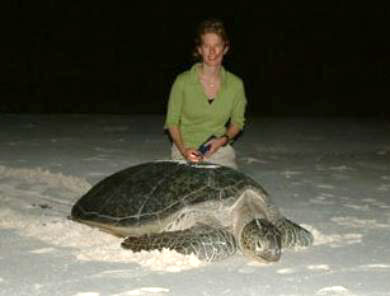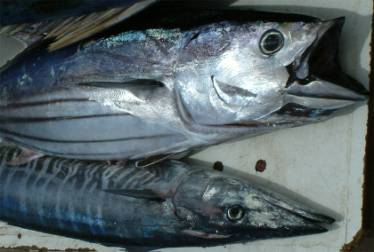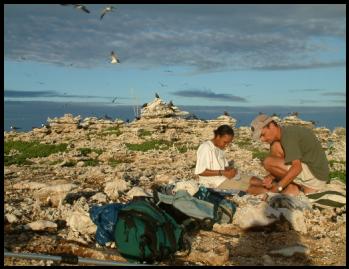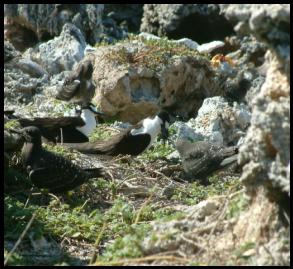|
Trophic ecology of
marine top predators from the Western Indian Ocean through the study of
trace element bioaccumulation and stable isotope ratios.
University
of La Réunion Research advisor:
Paco Bustamante, Associate Professor at La Rochelle University, CRELA
UMR 6217. Scientific
advisors:
Matthieu Le Corre, Associate Professor at La Reunion University, ECOMAR,
and Richard P. Cosson, Senior researcher at Nantes University, EMI EA
2663.
This work is funding
by the Conseil Régional de La Réunion and the European Social
Fund. Keywords
Context
The
Western Indian Ocean is considered as pristine because of its
geographical isolation. It is consequently an interesting “laboratory
site” for tracking potential variations in environmental trace element
levels, whether these variations be natural or anthropogenic. Aims
u
Obtain
baseline levels of trace elements in marine ecosystems of the Western
Indian Ocean through the study of bio-indicators (i.e. seabirds and
pelagic fish). u Investigate on the potential health hazard for Man of element levels in large pelagic fish of commercial importance.
u
Study
bioaccumulation and detoxification processes of mercury (Hg), lead (Pb),
cadmium (Cd), copper (Cu), iron (Fe), manganese (Mn), selenium (Se) and
zinc (Zn) in five species of fish (Xiphias gladius, Tunnus albacares,
Katsuwonus pelamis, Coryphaena hippurus et Acanthocybium solandri)
and six species of seabirds (Sterna fuscata, Anous stolidus,
Anous tenuirostris, Puffinus lherminieri, Pterodroma baraui et Phaeton
lepturus). u
Study
the trophic ecology of the predatory species mentioned above, using
trace elements and stable isotopes as bio-markers. Field investigations
• Sampling : Sampling of seabirds on Reunion Island, in Seychelles, in the Glorieuses Archipelago, on Juan de Nova and on Europa. Sampling of fish in waters surrounding Reunion Island and in the North of the Mozambique Canal.
• Trace elements : Top predators are exposed to trace elements through their prey. Studies
have shown that predators feeding preferentially on fish have higher
mercury levels than those which feed on squid, which in turn are vectors
of cadmium transfer to higher trophic levels. The analysis of trace
element levels in various tissues characterized by different turnovers (liver,
kidney, muscle and bird feathers) have provided new information on the
diets of the animals considered in my thesis. This knowledge is
complementary to that acquired by researchers of the ECOMAR and IRD
laboratories using traditional
methods. Furthermore,
I have focused on better understanding the fate of mercury, lead,
cadmium, copper, iron, manganese, selenium and zinc in each species
through the understanding of their bioaccumulation and detoxification
patterns.
• Stable isotopes :
The use of stable isotopes in ecology lies on the comparison of the
following ratios, 13C/12C (?13C) and 15N/14N
(?15N),
in the proteins of the predators tissues with those of prey tissues. ?13C,
which is hardly enriched from one trophic level to another (1‰), informs
on the food chain source of carbon and characterizes water masses. This
approach enabled me to glean comparative information on the foraging
areas of the different species. Conversely, ?15N
is enriched by 3 to 4‰ at each trophic
level and, hence, informs on the predator's trophic level. In
the light of these two markers, I work on better understanding the
trophic relationships that exist between top predators of various
ecosystems of the tropical Western Indian Ocean. Publications
Peer reviewed international journals Ø
J.
Kojadinovic, M. Potier, M. Le Corre, R.P. Cosson and P. Bustamante
(2006), Mercury content in commercial pelagic fish of the Western Indian
Ocean. The Science of the Total Environment, 21 pages, in press. Ø
J.
Kojadinovic, M. Le Corre, P. Bustamante, R.P. Cosson and M. Salamolard
(2006) Preliminary results on trace element levels in three species of
seabirds from Reunion Island (Western Indian Ocean). Ostrich, 13
pages, in press. National
journals Ø
Kojadinovic
J., Falquet M-P. and Conand C. (2004) Acanthaster planci on La
Reunion reefs. Reef encounter, 32: 26-27 (Australia). Submitted
journals Ø
J.
Kojadinovic, M. Le Corre, R.P. Cosson and P. Bustamante (2006) Trace
elements in three marine birds breeding on Reunion Island (Western
Indian Ocean) – Part 1: Factors influencing their bioaccumulation, 26
pages, submitted for second review in Archives of Environmental
Contamination and Toxicology. Ø
J.
Kojadinovic, P. Bustamante, M. Le Corre, and R.P. Cosson (2006) Trace
elements in three marine birds breeding on Reunion Island (Western
Indian Ocean) – Part 2: Factors influencing their detoxification, 20
pages, submitted for second review in Archives of Environmental
Contamination and Toxicology. Ø
J. Kojadinovic, M. Potier, M. Le Corre, R.P. Cosson and P.
Bustamante (2006) Bioaccumulation of trace elements in pelagic fish from
the Western Indian Ocean, 36 pages, submitted
at Environmental Pollution. Peer
reviewed international conference acts Ø
J.
Kojadinovic, M-P. Falquet, P. Mangion, C. Conand (2004) Distribution,
abundance and asexual reproduction of Asterina burtoni (Asteroidea:
Echinodermata) from La Reunion reefs (Western Indian Ocean). In:
Echinoderms: München - Heinzeller and Nebelsick (eds) - Taylor and
Francis Group, London, p 225-229. Meetings
Ø
Bioaccumulation of metals in three species of marine birds
from Reunion Island (Western Indian Ocean). J. Kojadinovic, P.
Bustamante and M. Le Corre - 11th Pan Africain Ornithological
Congress, 2004, Djerba, Tunisia. Ø
Bioaccumulation de métaux dans les grands prédateurs
marins de La Réunion (Océan Indien): cas de trois espèces d'oiseaux.
J. Kojadinovic, P. Bustamante, M. Le Corre, R.P. Cosson & M.
Salamolard - ``Jounées d'Ecologie Marine'' organised by the Société
Française d'Ecologie, 2004, Nantes, France. Ø
Distribution,
abundance and asexual reproduction of Asterina burtoni (Asteroidea
: Echinodermata) from La Reunion reefs (Western Indian Ocean), J.
Kojadinovic, M-P. Falquet, P. Mangion & C. Conand - 11th
International Echinoderm Conference, 2003, Munich, Germany -
Participation as chairman. Ø
Oral
communication on the Crown of Thorns starfish Acanthaster planci
in a meeting organised by the association Vie Océane. J.
Kojadinovic & M-P. Falquet, 2002, La Réunion, France. Posters Ø
Mercury
levels in four species of fish from the Mascarene Archipelago and the
Mozambique Channel (Western Indian Ocean). J. Kojadinovic, M. Potier, M.
Le Corre, R.P. Cosson and P. Bustamante, 4th Western Indian
Ocean Marine Science Association (WIOMSA) Scientific Symposium, 2005,
Grand Baie, Mauritius. Ø
Influence
of age, diet and reproductive status on trace element levels in three
seabirds from Reunion Island (Western Indian Ocean). J. Kojadinovic, P.
Bustamante, M. Le Corre and R.P. Cosson, Society of Environmental
Toxicology and Chemistry (SETAC) Europe, 15th Annual Meeting,
2005, Lille, France. |



